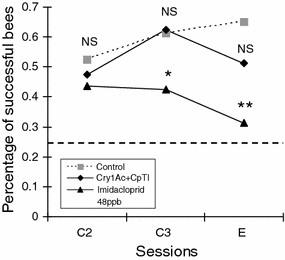Use of an innovative T-tube maze assay and the proboscis extension response assay to assess sublethal effects of GM products and pesticides on learning capacity of the honey bee Apis mellifera L
- PMID: 20872243
- PMCID: PMC2987206
- DOI: 10.1007/s10646-010-0546-4
Use of an innovative T-tube maze assay and the proboscis extension response assay to assess sublethal effects of GM products and pesticides on learning capacity of the honey bee Apis mellifera L
Abstract
Transgenic Cry1Ac+CpTI cotton (CCRI41) is a promising cotton cultivar throughout China but side effects and especially sublethal effects of this transgenic cultivar on beneficial insects remain poorly studied. More specifically potential sublethal effects on behavioural traits of the honey bee Apis mellifera L. have not been formally assessed despite the importance of honey bees for pollination. The goal of our study was to assess potential effects of CCRI41 cotton pollen on visual and olfactory learning by honey bees. After a 7-day oral chronic exposure to honey mixed with either CCRI41 pollen, imidacloprid-treated conventional pollen (used as positive sublethal control) or conventional pollen (control), learning performance was evaluated by the classical proboscis extension reflex (PER) procedure as well as a T-tube maze test. The latter assay was designed as a new device to assess potential side effects of pesticides on visual associative learning of honey bees. These two procedures were complementary because the former focused on olfactory learning while the latter was involved in visual learning based on visual orientation ability. Oral exposure to CCRI41 pollen did not affect learning capacities of honey bees in both the T-tube maze and PER tests. However, exposure to imidacloprid resulted in reduced visual learning capacities in T-tube maze evaluation and decreased olfactory learning performances measured with PER. The implications of these results are discussed in terms of risks of transgenic CCRI41 cotton crops for honey bees.
Figures



Similar articles
-
Quantification of toxins in a Cry1Ac + CpTI cotton cultivar and its potential effects on the honey bee Apis mellifera L.Ecotoxicology. 2010 Nov;19(8):1452-9. doi: 10.1007/s10646-010-0530-z. Epub 2010 Aug 11. Ecotoxicology. 2010. PMID: 20700762 Free PMC article.
-
Does transgenic Cry1Ac + CpTI cotton pollen affect hypopharyngeal gland development and midgut proteolytic enzyme activity in the honey bee Apis mellifera L. (Hymenoptera, Apidae)?Ecotoxicology. 2012 Nov;21(8):2214-21. doi: 10.1007/s10646-012-0976-2. Epub 2012 Aug 7. Ecotoxicology. 2012. PMID: 22868904
-
Does Cry1Ab protein affect learning performances of the honey bee Apis mellifera L. (Hymenoptera, Apidae)?Ecotoxicol Environ Saf. 2008 Jun;70(2):327-33. doi: 10.1016/j.ecoenv.2007.12.002. Epub 2008 Feb 21. Ecotoxicol Environ Saf. 2008. PMID: 18206234
-
Neonicotinoids in bees: a review on concentrations, side-effects and risk assessment.Ecotoxicology. 2012 May;21(4):973-92. doi: 10.1007/s10646-012-0863-x. Epub 2012 Feb 18. Ecotoxicology. 2012. PMID: 22350105 Free PMC article. Review.
-
Chronic Effects of Imidacloprid on Honey Bee Worker Development-Molecular Pathway Perspectives.Int J Mol Sci. 2021 Oct 31;22(21):11835. doi: 10.3390/ijms222111835. Int J Mol Sci. 2021. PMID: 34769266 Free PMC article. Review.
Cited by
-
Short-term and transgenerational effects of the neonicotinoid nitenpyram on susceptibility to insecticides in two whitefly species.Ecotoxicology. 2012 Oct;21(7):1889-98. doi: 10.1007/s10646-012-0922-3. Epub 2012 Jun 2. Ecotoxicology. 2012. PMID: 22661314
-
Laboratory Evaluation of Different Insecticides against Hibiscus Mealybug, Maconellicoccus hirsutus (Hemiptera: Pseudococcidae).Scientifica (Cairo). 2016;2016:9312013. doi: 10.1155/2016/9312013. Epub 2016 May 22. Scientifica (Cairo). 2016. PMID: 27313962 Free PMC article.
-
Limitations of learning in the proboscis reflex of the flower visiting syrphid fly Eristalis tenax.PLoS One. 2018 Mar 20;13(3):e0194167. doi: 10.1371/journal.pone.0194167. eCollection 2018. PLoS One. 2018. PMID: 29558491 Free PMC article.
-
Effects of neonicotinoids and fipronil on non-target invertebrates.Environ Sci Pollut Res Int. 2015 Jan;22(1):68-102. doi: 10.1007/s11356-014-3471-x. Epub 2014 Sep 17. Environ Sci Pollut Res Int. 2015. PMID: 25223353 Free PMC article. Review.
-
Imidacloprid alters foraging and decreases bee avoidance of predators.PLoS One. 2014 Jul 15;9(7):e102725. doi: 10.1371/journal.pone.0102725. eCollection 2014. PLoS One. 2014. PMID: 25025334 Free PMC article.
References
-
- Blight MM, Le Metayer M, Pham-Delègue MH, Pickett John A, Marion-Poll F, Wadhams LJ. Identification of floral volatiles involved in recognition of oilseed rape flowers, Brassica napus by honeybees, Apis mellifera. J Chem Ecol. 1997;23:1715–1727. doi: 10.1023/B:JOEC.0000006446.21160.c1. - DOI
-
- Bonmatin JM, Moineau I, Charvet R, Colin ME, Fleche C, Bengsch ER. Behaviour of imidacloprid in fields. In: Lichtfouse E, Schwarzbauer J, Robert D, editors. Environmental chemistry: green chemistry and pollutants in ecosystems. Berlin: Springer; 2005. pp. 483–494.
Publication types
MeSH terms
Substances
LinkOut - more resources
Full Text Sources

